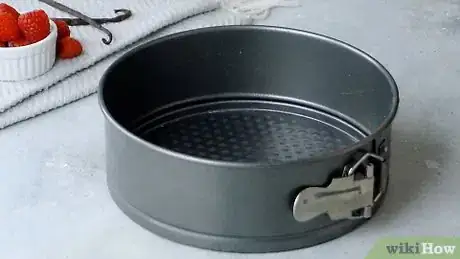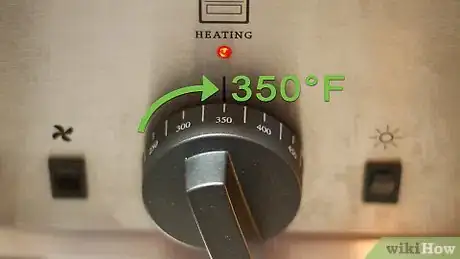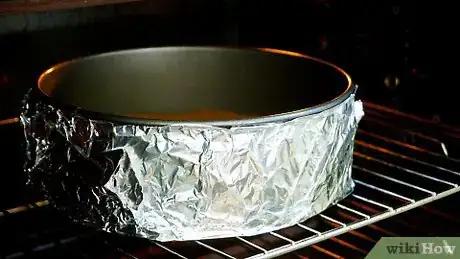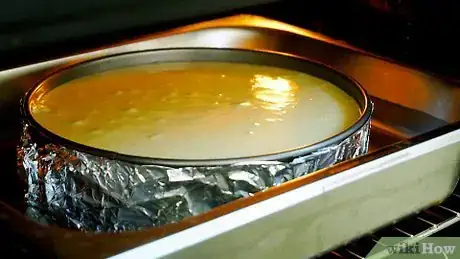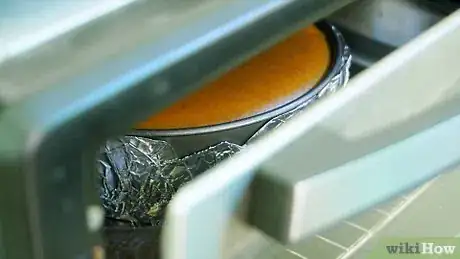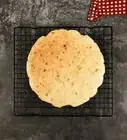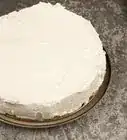This article was co-authored by Maria Short. Maria Short is a Baker and the Owner of Short N Sweet Bakery & Cafe in Hilo, Hawaii. With over 24 years of experience, she specializes in specialty desserts and wedding cakes. She graduated from L’Academie de Cuisine’s Pastry Arts Program with honors and studied at Baltimore International Culinary College. In 2019, Maria competed in the 6th season of the Food Network’s Holiday Baking Championship. In 2010, she had a cake named one of “America’s Most Beautiful Cakes” by Brides magazine.
This article has been viewed 318,984 times.
Cheesecake has long been considered one of the most decadent desserts by food lovers everywhere. While the prep and cooking time is generally 3 hours, this creamy, dreamy dessert is truly worth it.
Ingredients
- 2 cups (475 ml) of graham cracker crumbs (from a little less than 2 packages graham crackers)
- 2 Tbsp (12.5 g) of granulated sugar
- 5 Tbsp (70 g) of unsalted butter, melted
- A pinch of salt (if you’re using salted butter, omit the pinch of salt)
- 2 pounds (900 g) of cream cheese, room temperature
- 1 1/3 cups (270 g) of granulated sugar
- A pinch of salt
- 2 teaspoons (9.9 mL) of vanilla extract
- 4 large eggs
- 2⁄3 cup (160 mL) of sour cream
- 2⁄3 cup (160 mL) of heavy whipping cream
Steps
Making the Crust
-
1Use a springform pan. Cheesecakes are notoriously crumbly, so choosing the right pan will ensure that your cheesecake comes out smoothly when you take it out of the pan. For the best outcome, use a springform pan. This sort of pan is comprised of round cake pan with a removable bottom. It is all held together by a sprung collar.[1]
-
2Wrap the pan with aluminum foil. For the best cheesecake you’ve ever eaten, you’ll need to bake it surrounded by boiling water. To avoid any water leaking into your pan and ruining your crust, you will need to wrap the outside of the pan with hole-free aluminum foil. Place a piece of foil under the pan and then wrap it upwards and fold it so that the foil rests along the edge of the pan but doesn’t fold over the lip.[2]
- If needed, use a second piece of foil to cover any spots that the first piece missed.
Advertisement -
3Preheat the oven to 350 °F (177 °C). Before you turn on the oven, place a rack in the lower third of the oven and so that the cheesecake will fit near the bottom. Let the oven preheat while you make the crust.
-
4Grind the graham crackers. Place 2 cups (475 ml) of graham crackers into a blender or food processor. Make sure that the lid is tightly secured and pulse the crackers until they reach a finely ground texture.
- Alternatively, you can put the graham crackers in a resealable bag and squeeze out all the air. Use a rolling pin or other heavy object to beat the crackers until they're broken up into crumbs.
-
5Combine all of the ingredients for the crust in a large bowl. Put the graham cracker crumbs in a large bowl, then use a spatula to stir in 2 Tbsp (12.5 g) of granulated sugar and a pinch of salt. Make sure that all of the ingredients are thoroughly mixed. Melt 5 Tbsp (70 g) of unsalted butter in the microwave or on the stove and then add it to the mixture.[3]
- Use clean hands or a spatula to mix the ingredients together using a folding movement until all the ingredients are well mixed.
- If you chose to use salted butter, don’t add the pinch of salt.
-
6Press the crust mixture into the pan. Save about ¼ cup (~20 g) of the mixture to use later if need be (you can use it if you discover any holes in your crust once you remove it from the pan). Pour the mixture into the pan, then press the crust down with your hands, making sure that there are no holes. The result should be an even layer of crust that ever so slightly curves up along the edges of the pan.
- While pressing the crust into the pan, make sure that you do not accidentally tear any of the foil. If you do notice a tear, replace it with a different piece of tin foil.
-
7Cook the crust for 10 minutes, then turn down the heat. The crust will need to harden up a bit—putting it in the oven for 10 minutes should achieve the desired texture. Once the 10 minutes have passed, remove the pan from the oven and turn the oven temperature down to 325 °F (163 °C). Let the crust cool for several minutes.
Making the Filling
-
1Mix 2 pounds (900 g) of cream cheese. Allow the cream cheese to come up to room temperature before using it. One by one, cut away a chunk of the cream cheese and place it into the bowl of your electric mixer. Use the paddle attachment of your electric mixture to get the creamiest texture. Mix the cream cheese for 4 minutes on a medium speed—the result should be a smooth texture.
-
2Add the sugar, vanilla, and salt to the cream cheese, mixing after each ingredient. Pour 1 1/3 cups (270 g) of granulated sugar into the bowl and mix the 2 ingredients together for 4 minutes. Your mixture should be set to a medium speed. Add 2 teaspoons (9.9 mL) of vanilla extract and then mix for 4 minutes. Then, add a pinch of salt and mix for another 4 minutes.[4]
-
3Beat the eggs into the mixture. Add 1 egg, turn the mixer on, and beat it for 1 minute. Repeat this process with the 3 remaining eggs. Use a spatula to scrape along the insides and bottom of the mixing bowl. This is important to do because large chunks of cream cheese can get stuck in these areas.
-
4Add sour cream and heavy cream. Next, add 2⁄3 cup (160 mL) of sour cream and mix thoroughly. Follow this up with 2⁄3 cup (160 mL) of heavy whipping cream, which you should also mix until the ingredients are all blended together.
-
5Pour the filling into the pan on top of the crust. Make sure that you scoop out all of the filling while also making sure that it doesn’t overflow the pan. Once it is in the pan, use a spatula to make the top smooth.[5]
Baking the Cheesecake
-
1Place the springform pan into a high-sided roasting pan containing hot water. Bring 8 cups (1,900 mL) of water to a boil. Once the water is boiling, carefully pour it into the roasting pan so that the water reaches about halfway up the side of the springform pan.[6]
- While this might sound like an odd instruction, you are actually giving the cake a water bath that will help the filling to cook without cracking.[7]
-
2Cook the cheesecake for 1.5 hours. Place the roasting pan on the lower rack of the oven. Set your timer for 1.5 hours and let your delicious cheesecake bake. After 45 minutes, rotate the cheesecake 180 degrees to ensure it cooks evenly.[8]
- After the baking time has passed, open the oven and gently shake the cheesecake back and forth to ensure doneness. The cake should wiggle slightly in the center and should be firm around the edge. The center will firm up as the cake cools.
-
3Turn off the heat and crack the oven door for 1 hour. Open the door of the oven about 1 inch (2.5 cm). Let the cheesecake cool in the oven as the oven cools, which should take about 1 hour. This sort of slow, gentle cooling will make sure that the filling doesn’t crack in the face of the cold air outside the oven.
-
4Cover the top of your cheesecake with foil and place it in the fridge. You will want to leave it in the fridge for a minimum of 4 hours. The cold temperature will help the cheesecake to firm up.
- Some dessert chefs believe the cheesecake should be cooled uncovered for 2 to 3 hours. Chilling the cheesecake this way also helps to disperse the moisture that would otherwise form on the top of the cheesecake.[9]
- You should see that a cheesecake is completely chilled before you remove it from the pan.
- If you do not wait until it's completely chilled, it will stick, crack, and be a mess.
-
5Remove your cheesecake from the pan. Once it has chilled thoroughly, you can slide a spatula along the inside of the pan to separate the crust and cake from the pan. You must wait to do this until after the cheesecake has cooled or else you run the high risk of separating the cheesecake from its crust.[10]
- Open the springform latch and gently remove the sides, leaving the cheesecake in all its glory. Then, carefully remove the bottom of the springform pan while transferring the cake to a plate or platter.
-
6Serve the cheesecake and enjoy! You can add toppings, like strawberries or raspberries, or drizzle chocolate over the top, if desired.
Community Q&A
-
QuestionDo I have to use an oven to make this or can I use the fridge instead?
 QamarTop AnswererNo, you need to bake the cheesecake in the oven. Look for a no-bake cheesecake recipe.
QamarTop AnswererNo, you need to bake the cheesecake in the oven. Look for a no-bake cheesecake recipe. -
QuestionHow much time does it take to make?
 Community AnswerThe whole process of constructing and baking the cheesecake (including cooling time) takes approximately one hour. After the cheesecake has been made and cooled, you should refrigerate it for a minimum of 4 hours.
Community AnswerThe whole process of constructing and baking the cheesecake (including cooling time) takes approximately one hour. After the cheesecake has been made and cooled, you should refrigerate it for a minimum of 4 hours. -
QuestionHow can I make a cheesecake more simply?
 Community AnswerPreheat oven to 350 degrees F (175 degrees C). Beat softened cream cheese slightly. Add eggs, sugar, vanilla, and lemon zest. Beat until light and fluffy. Bake at 350 degrees F (175 degrees C) until firm, about 25 minutes. Let the cheesecake cool, then top with cherry or strawberry preserves.
Community AnswerPreheat oven to 350 degrees F (175 degrees C). Beat softened cream cheese slightly. Add eggs, sugar, vanilla, and lemon zest. Beat until light and fluffy. Bake at 350 degrees F (175 degrees C) until firm, about 25 minutes. Let the cheesecake cool, then top with cherry or strawberry preserves.
References
- ↑ http://www.bhg.com/recipes/how-to/bake/how-to-make-cheesecake/
- ↑ http://www.simplyrecipes.com/recipes/perfect_cheesecake/
- ↑ http://www.simplyrecipes.com/recipes/perfect_cheesecake/
- ↑ http://www.simplyrecipes.com/recipes/perfect_cheesecake/
- ↑ http://www.bhg.com/recipes/how-to/bake/how-to-make-cheesecake/
- ↑ http://www.bettycrocker.com/how-to/tipslibrary/baking-tips/how-to-make-bake-cheesecake
- ↑ https://sallysbakingaddiction.com/2014/05/24/prevent-cracks-cheesecake/
- ↑ https://www.cooksillustrated.com/how_tos/5583-staggering-and-rotating-during-baking
- ↑ http://www.bettycrocker.com/how-to/tipslibrary/baking-tips/how-to-make-bake-cheesecake
About This Article
To make a baked cheesecake, combine the ingredients for the crust, press the mixture into a springform pan, and bake the crust for 10 minutes. Next, combine cream cheese, heavy cream, sour cream, sugar, vanilla, and eggs to make the filling and pour it over the pre-baked crust. Then, add hot water to a roasting pan, place the springform pan into the water, and bake the cheesecake for 1.5 hours. Let the cheesecake cool and refrigerate it for 4 hours before serving it! For tips on adding delicious toppings, read on!
